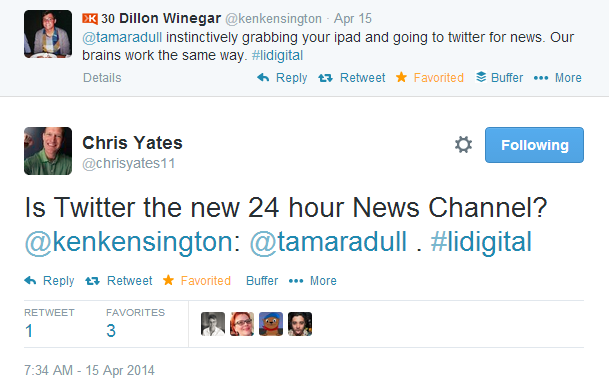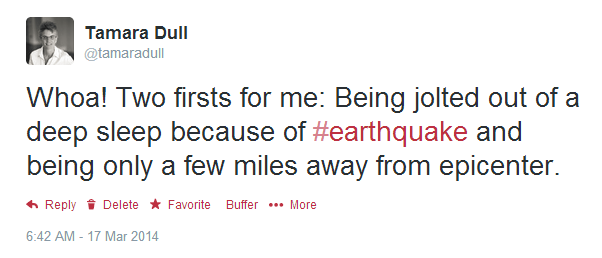THUMP.
Jolted out of a deep sleep, I intuitively sat straight up in bed. What had just happened? It felt like the house had just jumped. But wait: Houses don’t jump. Still groggy, I squinted at the clock across the room to check out the time. It was 6:25 A.M. I looked towards the window and I could see the early morning sun starting to crack through the drawn curtains.
Still not sure what was going on, I got out of bed to go grab my iPad, which was charging in the kitchen. As I walked across the house (which seemed to be fully intact even after “jumping”), I began to wonder if I had just experienced an earthquake. If this was an earthquake, it was different than anything I had experienced before. As a native Californian, I’ve been through my fair share of “shakers” and a few “rollers,” but I’ve never experienced a “jumper” before.
I grabbed my iPad, walked back to the bedroom, and got myself situated comfortably on the bed again. I opened my iPad, tapped the Twitter app icon, and typed “earthquake” into the search field to see if anyone else was tweeting about earthquakes.
Twitter did not disappoint. The search results came streaming back: It was an earthquake. I watched as the new tweets came flooding in – not only from folks in the L.A. area, but from around the world. I felt oddly comforted by the fact that I wasn’t alone on this abrupt start to St. Patrick’s Day.
After about 15 minutes, I turned on the TV to see what ABC News was reporting. They confirmed that we had just experienced a 4.4-magnitude earthquake. No damage had yet been reported (good!), but I learned that the epicenter was only a few miles from home (really?!). I then tweeted:
Fast forward to April 15th. I am at the Long Island Digital Summit getting ready to deliver my big data keynote. The conference had kicked off in high-gear with David “Shingy,” the Digital Prophet from AOL. His fast-paced, upbeat and witty presentation engaged, educated and entertained us all. We learned that the smartphone is our “first device” – i.e., the device we go to first to connect with our world – and that the typical smartphone user accesses his phone ~150 times a day. A key takeaway for marketers: If you want to connect with your audience, you need to meet them where they’re at in the context of their digital world.
Next on the agenda was Amanda Farrell from Twitter. One of her key themes was how Twitter has changed how we interact with our world, and she provided several great examples. I couldn’t help but think about my own March 17th experience with Twitter. Amanda’s presentation was then followed by a great panel discussion on digital strategy with executives from 1-800-FLOWERS, Mashable, Red Mango, and Canon.
And then it was my turn.
I was already thanking my lucky stars that I didn’t have to follow Shingy’s TEDtalk-like presentation. But after hearing both him and Amanda, I decided to swap out my planned introduction with a story. My story about the earthquake I experienced on March 17th and how I used my first device to access Twitter to connect with my world in real-time.
As I told my story, these tweets appeared in the #LIdigital Twitter stream:

We have moved into a hyper-connected digital age. What this means for marketers is that digital outreach is no longer a question of if, but a question of when.
What's the status of your digital marketing strategy? It may not rock everyone's world, but it should definitely wake your customers up.
For additional digital insights, check out the Long Island Digital Summit recap.


